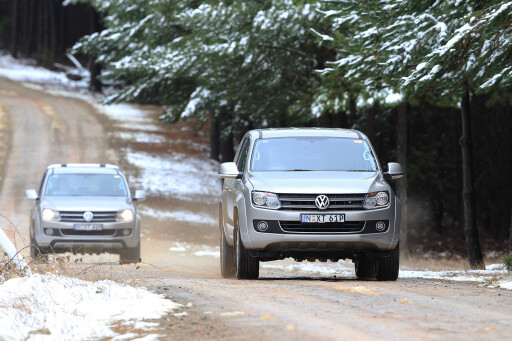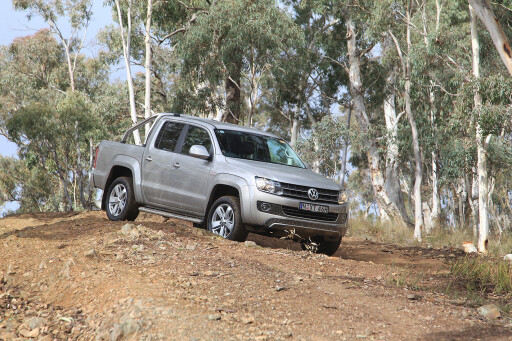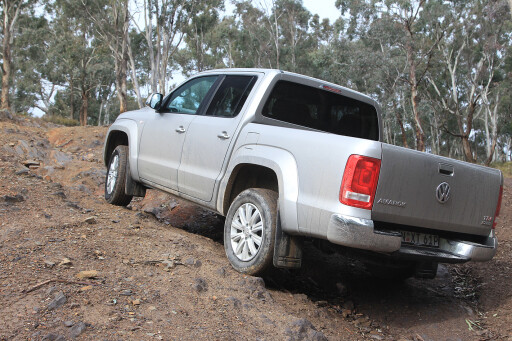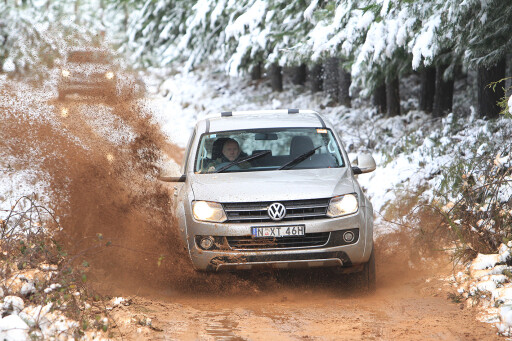
IT'S half past five in the morning, and the higher parts of the Great Dividing Range in NSW’s Central Tablelands are blanketed with snow.
This article was first published in 4x4 Australia's September 2011 issue.
The VW’s ice warning is telling me the obvious: it’s bloody cold outside. Worst still, the paucity of wheel tracks in the fresh snow ahead suggest I’m one of the first mugs out of bed and onto this snow-covered back road this wintery morn. Not that the snow is consistently thick.
The strong winds mean it is coming in more horizontal than vertical. In the lee of the plantation pines that line the road, or adjacent to the road’s many cuttings, the bitumen is as good as snow-free. In exposed areas, however, the snowdrifts seem quite deep, given the at-times unnerving feel of the steering wheel.
 I’m driving Volkswagen’s new Amarok. It’s a Highline model fitted with what VW calls 4Motion Selectable; what you or I would call part-time, dual-range 4X4, and essentially the same sort of system found in your typical Japanese ute.
I’m driving Volkswagen’s new Amarok. It’s a Highline model fitted with what VW calls 4Motion Selectable; what you or I would call part-time, dual-range 4X4, and essentially the same sort of system found in your typical Japanese ute.
I’m meeting with my road-test partner, who’s driving an Ultimate Amarok fitted with 4Motion Permanent which, in layman’s terms, is single-range, full-time 4X4. He’s coming up from Sydney, a couple of hundred kays from where I am now, with no doubt decidedly warmer weather.
The purpose of this test is to compare the two different Amarok 4X4 systems and, ironically, the conditions I’m now facing are tailor-made for the Amarok I’m not driving.
THE BASICS
VW’s Amarok, which is currently only available as a dual-cab with manual transmission, follows the basic design parameters of its Japanese competition in as much as it’s built on a separate chassis, has a leaf-sprung live axle at the rear and independent (in this case coil springs and double wishbones) front suspension.
The part-time, dual-range 4X4 system also follows accepted design practice in this class. Where the Amarok differs from the likes of HiLux, Navara and Triton, is with the availability of the single-range full-time 4X4 system (in the top-spec model), and with its engine.
 Whereas the norm with the Japanese utes is either a 2.5 or 3.0-litre single-turbo four-cylinder diesel, the Amarok uses a 2.0-litre bi-turbo four-cylinder diesel. The Amarok’s two turbos are different sizes and arranged in sequence, rather than in parallel. Off idle, and at lower engine speeds and loads, the smaller of the two turbos gets things underway.
Whereas the norm with the Japanese utes is either a 2.5 or 3.0-litre single-turbo four-cylinder diesel, the Amarok uses a 2.0-litre bi-turbo four-cylinder diesel. The Amarok’s two turbos are different sizes and arranged in sequence, rather than in parallel. Off idle, and at lower engine speeds and loads, the smaller of the two turbos gets things underway.
As the speed and loads increase, the bigger turbo gradually takes over, at first working in partnership with the smaller, but eventually running the show on its own.
WHAT’S THE SAME?
Whether you’re driving the Amarok with 4Motion Selectable or 4Motion Permanent, you’ll be impressed by the performance and general civility of the bi-turbo diesel engine. Compared to its Japanese rivals, it is quiet, smooth and refined. It also offers an encouraging spread of power from not far off idle, almost through to redline.
For a manual, it’s quite tall geared (around 58km/h/1000rpm in sixth) yet, on the highways and byways, it carries this tall gearing with aplomb, storming up decent hills in top gear without even thinking of asking for a lower cog. For this you can thank the 400Nm of torque available from as low as 1500rpm.
 Given the tall gearing, this means maximum torque is available in top gear from below 90km/h all the way to 145km/h. Claimed maximum power is a reasonable – but not stunning – 120kW. So, while the engine’s flexibility is first-class, it’s no barnstormer in the higher reaches. It does, however, offer excellent economy.
Given the tall gearing, this means maximum torque is available in top gear from below 90km/h all the way to 145km/h. Claimed maximum power is a reasonable – but not stunning – 120kW. So, while the engine’s flexibility is first-class, it’s no barnstormer in the higher reaches. It does, however, offer excellent economy.
The official ADR figure for the full-time and part-time models is 7.9L/100km, and both our test vehicles averaged a respectable 9.1L/100km over a broad mixture of driving conditions. That’s marginally better than what you’d expect of any of the Japanese competition under similar circumstances.
 Not so good is the combination of the clutch take up and the engine’s idle-speed torque, which conspire to make take-offs something of an art. Thankfully, practice, as they say, makes perfect. The gearbox also needs some familiarity, as the gate is not as well defined as it could be, and very closely spaced.
Not so good is the combination of the clutch take up and the engine’s idle-speed torque, which conspire to make take-offs something of an art. Thankfully, practice, as they say, makes perfect. The gearbox also needs some familiarity, as the gate is not as well defined as it could be, and very closely spaced.
It’s pretty good once on the move, but finding third when you’re looking for first is too easy to do until you get used to it.
WHAT’S DIFFERENT?
Leaving aside the fact that the 4Motion Permanent system is only available in the top-spec Ultimate model, which comes with leather seats and 19-inch wheels, there are a few other key differences.
While the Ultimate can be had with the 4Motion Selectable system, when you opt for the 4Motion Permanent system, you also get what’s called Comfort suspension rather than the standard Heavy Duty. Among other things, this reduces the GVM from 3040kg to 2820kg.
 On the road, this means the 4Motion Permanent rides a little softer than the 4Motion Selectable, despite its 19-inch wheels in place of the 18s on the Highline. Its handling is also more composed on crook roads, and more neutral when pushed hard. More telling, however, is its ability and confidence in marginal and inconsistent conditions, such as the snow-covered roads detailed above.
On the road, this means the 4Motion Permanent rides a little softer than the 4Motion Selectable, despite its 19-inch wheels in place of the 18s on the Highline. Its handling is also more composed on crook roads, and more neutral when pushed hard. More telling, however, is its ability and confidence in marginal and inconsistent conditions, such as the snow-covered roads detailed above.
Volkswagen Amarok Sportline V6 in showrooms this August
The problem with the 4Motion Selectable part-time system in these conditions is that you can’t use 4X4 on the bits with good traction. So, when the road is constantly changing from slippery to grippy without notice, you have to make do with rear-wheel drive.
Thankfully, all Amarok models come with electronic stability control, so you have a ‘safety net’, but either way, full-time 4X4 is a better bet under these conditions. Traction and ride quality differences aside, all Amaroks offer a level of on-road ride and handling that the Japanese utes just can’t match.
 Venturing off-road, however, sees the 4Motion Selectable Amarok quickly turn the tables on its Permanent counterpart. While the single-range Amarok still has adequate ground clearance and underbody protection, and enjoys the benefits of a rear diff lock, electronic traction control and an off-road setting for its ABS and electronic stability control, it doesn’t like tackling steep hills.
Venturing off-road, however, sees the 4Motion Selectable Amarok quickly turn the tables on its Permanent counterpart. While the single-range Amarok still has adequate ground clearance and underbody protection, and enjoys the benefits of a rear diff lock, electronic traction control and an off-road setting for its ABS and electronic stability control, it doesn’t like tackling steep hills.
With the aforementioned issue of clutch take up, it’s too easy to stall on take off and, even if you get underway, the tall first gear soon has the engine struggling for revs on any sort of decent hill climb. In contrast, the dual-range Amarok offers class-leading off-road ability.
It has all the off-road features of the single-range model, but the unusually deep (2.72:1) low-range reduction makes all the difference and turns the Amarok from a modest off-road performer to a very capable one.
CONCLUSION
Volkswagen has no doubt produced a brilliant ute, but the two different 4X4 systems complicates the purchasing decision. If you’re after a touring 4X4 and hardcore off-roading is not a priority, then the 4Motion Permanent system is for you.
It offers more secure handling in marginal conditions and the slightly softer Comfort suspension adds a range of benefits if carrying maximum loads isn’t vital. If, however, you want genuine 4X4 ability, the only choice is the 4Motion Selectable system.
With this you get the Heavy Duty suspension as standard, but can still opt for Comfort. And, while the Amarok comes with wheel sizes ranging from 16 to 19-inch, the 16s can be retro-fitted to all models; a bonus if you wish to fit tyres better suited to serious off-roading.
 All 4X4 Amaroks, regardless of drive system, have a five-star (ANCAP) safety rating; the only ute in its class to do so. The cabin is also a standout with comfort levels more akin to a passenger car than commercial vehicle.
All 4X4 Amaroks, regardless of drive system, have a five-star (ANCAP) safety rating; the only ute in its class to do so. The cabin is also a standout with comfort levels more akin to a passenger car than commercial vehicle.
It’s just a pity that VW didn’t go one step further and equip its Amarok with full-time dual-range 4X4 across the range, rather than the existing options. I’m sure the system from the now superseded first-generation Touareg would have done the job nicely.
And it would have saved me getting out of bed on this miserable morning to see how the two existing 4X4 systems compare.

COMMENTS